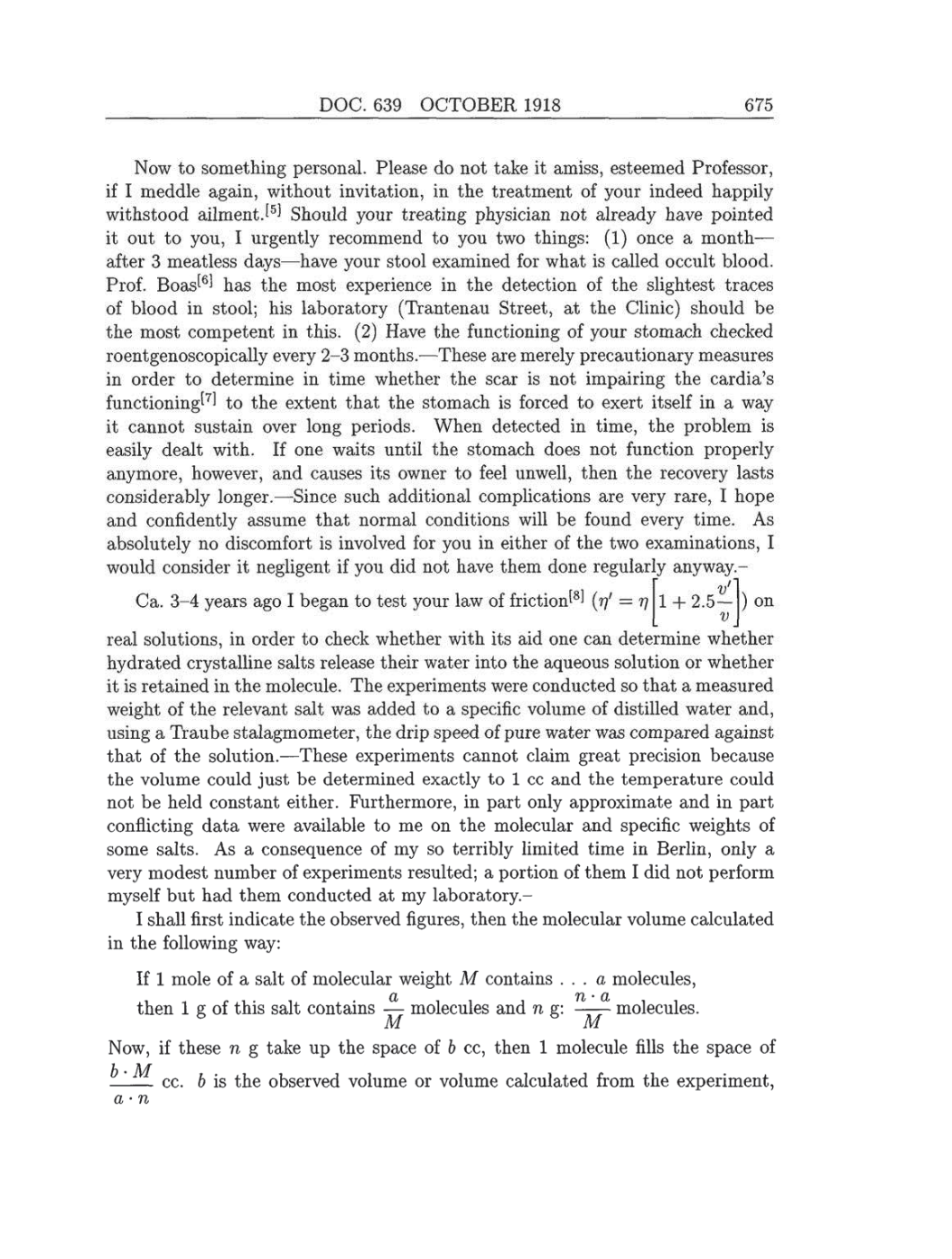DOC.
639
OCTOBER
1918 675
Now to
something personal.
Please do not take
it
amiss,
esteemed
Professor,
if I
meddle
again,
without
invitation,
in
the
treatment of
your
indeed
happily
withstood
ailment.[5]
Should
your
treating
physician
not
already
have
pointed
it
out
to
you,
I
urgently
recommend to
you
two
things:
(1) once a
month–
after
3
meatless days-have
your
stool examined for
what
is
called occult blood.
Prof.
Boas[6]
has
the
most
experience
in
the
detection
of
the
slightest
traces
of blood in
stool;
his
laboratory
(Trantenau Street,
at
the
Clinic)
should be
the
most
competent
in this.
(2)
Have
the
functioning
of
your
stomach checked
roentgenoscopically every
2-3
months.-These
are
merely
precautionary
measures
in
order
to determine in time whether
the
scar
is
not
impairing
the
cardia’s
functioning[7]
to
the
extent
that the
stomach
is
forced to exert itself in
a
way
it cannot
sustain
over
long periods.
When detected in
time,
the
problem
is
easily
dealt
with. If
one
waits until
the
stomach
does not
function
properly
anymore, however,
and
causes
its
owner
to
feel
unwell,
then the
recovery
lasts
considerably
longer.-Since
such
additional
complications
are
very rare,
I
hope
and
confidently
assume
that
normal conditions
will
be found
every
time. As
absolutely
no
discomfort
is
involved
for
you
in either of
the
two
examinations,
I
would consider
it
negligent
if
you
did not have them done
regularly
anyway.-
Ca. 3-4
years ago
I
began
to
test
your
law
of friction[8]
(n'
=
n
1
+ 2.5-
v' on
real
solutions,
in order to check whether with its aid
one can
determine
whether
hydrated
crystalline
salts
release
their
water into the
aqueous
solution
or
whether
it
is
retained
in
the
molecule. The
experiments
were
conducted
so
that
a
measured
weight
of
the
relevant
salt
was
added to
a
specific
volume
of
distilled water
and,
using
a
Traube
stalagmometer,
the
drip speed
of
pure
water
was
compared against
that
of
the
solution.-These
experiments
cannot claim
great
precision
because
the volume could
just
be determined
exactly
to
1
cc
and
the
temperature
could
not be held constant either.
Furthermore,
in
part
only approximate
and
in
part
conflicting
data
were
available to
me on
the
molecular and
specific weights
of
some
salts. As
a
consequence
of
my
so
terribly
limited time in
Berlin, only
a
very
modest
number of
experiments
resulted;
a
portion of
them I did not
perform
myself
but
had them
conducted
at
my
laboratory.-
I
shall first indicate
the
observed
figures,
then the
molecular volume calculated
in
the
following
way:
If
1
mole of
a
salt of molecular
weight
M
contains
...
a
molecules,
then
1
g
of
this salt
contains
a/M
molecules and
n
g:
n.a/M
molecules.
Now,
if
these
n g
take
up
the
space
of
b cc,
then
1
molecule
fills
the
space
of
b.M/a.n
cc.
b
is
the
observed volume
or
volume calculated from
the
experiment,
